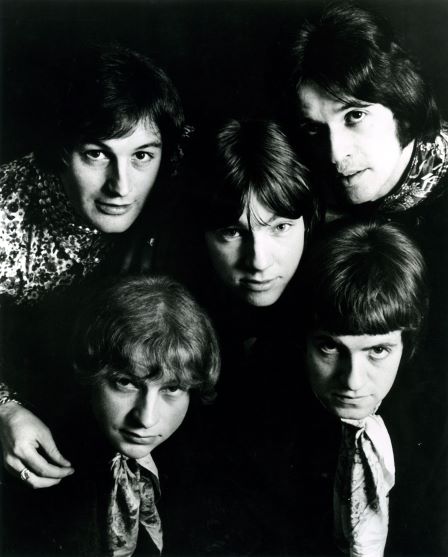
Blues-rock aggregation Gethsemane was the final version of a group that guitarist Martin Barre (b. 17 November 1946, King’s Heath, Birmingham) had first joined in July 1966 before landing the “gig of his dreams” with Jethro Tull.
Bass player and leader Bryan Stevens (b. 13 November 1941, Lha Datu, North Borneo) and keyboard player/singer Mick Ketley (b. 1 October 1947, Balham, London) were there from the outset, having been integral members of Beau Brummell & The Noblemen from late 1964 to June 1966.
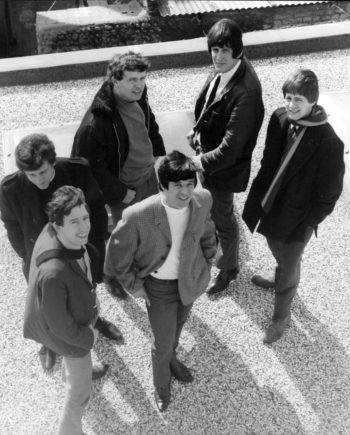
Returning to England after touring Europe, Stevens and Ketley had decided to put together a new version of The Noblemen, adding new musicians, including drummer Malcolm Tomlinson (b. 16 June 1946, Isleworth, Middlesex; d. 2 April 2016) from west London and Martin Barre.
All four musicians survived the group’s evolution from Mod/soul outfit Motivation through to psychedelic pop band The Penny Peep Show/Penny Peeps.
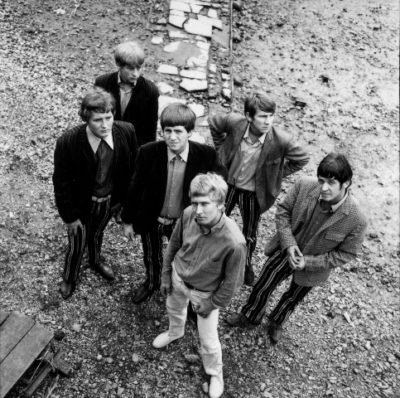
However, despite garnering plenty of work on the club scene in the first half of 1968, the emerging blues explosion headed up by Fleetwood Mac was starting to make psychedelic rock bands redundant.
That July, Canadian group The Band’s Music from Big Pink had been given a UK release and had turned musicians’ heads, The Penny Peeps included.
After playing at Nottingham’s Beachcomber Club on Saturday, 13 July; Leicester Rowing Club, two Saturdays later; and the Swan in Yardley, the West Midlands on Saturday, 3 August, the musicians realised another change in style was required.
The decision was influenced in part by the audience’s response at one particular gig (possibly the Walgrave in Coventry on Sunday, 4 August) where the group’s performance was poorly received.
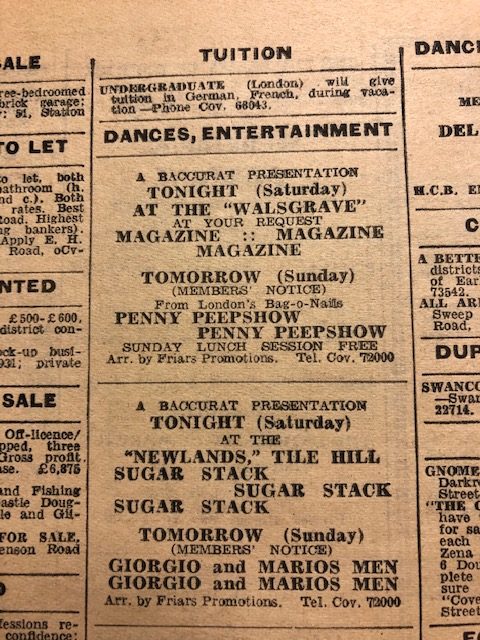
In the interval, the band’s current singer Denny Alexander suggested that the band play some blues numbers in the second set and with Mike Ketley and Malcolm Tomlinson also helping out with lead vocals, the fresh approach went down a storm.
Taking on a new name, In the Garden of Gethsemane, which was soon shortened to Gethsemane, the group began to plough a more blues-based direction.
The decision to adopt a new style may also have been prompted by the Eighth National Jazz and Blues Festival held at Kempton Park racecourse in Sunbury-on-Thames on Sunday, 11 August.
Malcolm Tomlinson had attended and was blown away by Jethro Tull and its enigmatic front-man Ian Anderson whose mastery of the flute made an impression on the drummer. Both he and Martin Barre had recently started to play flute and Tomlinson came back raving about the group to Barre, urging the guitarist to check out Anderson’s inspirational group.
Around this time, however, Denny Alexander dropped out to pursue a non-musical career.
Reduced to a quartet, the new musical direction that Gethsemane took gave the band an opportunity to be more creative and to stretch out during live performances. One of the “features” of the band’s stage show during this period was a flute duet featuring Barre and Tomlinson.
Mike Ketley believes the genesis of Gethsemane began when the musicians played an (unadvertised) all-nighter at the Gunnell brothers’ Flamingo in Wardour Street around mid-to-late August.
“What I remember is Malc Tomlinson on drums, Bryan on bass, Martin Barre on guitar and me on Hammond. We were definitely a four piece there and by then Malc had decided to take up the flute. Martin by this time was becoming a much better flute player than he was a sax player.
“One of our set numbers was ‘Work Song’ made famous by Cannonball Adderley plus others. After we had played the main theme twice through with some ad lib from me and Martin, Malc said play some percussion rhythm on the keys and he came out from behind the drums flute in hand and between him and Martin, who by then had realised this was something completely spontaneous, we played some pretty bizarre stuff, completely unrehearsed with two flutes talking to each other, while Bryan did his own thing on bass in line with me just using the percussion tabs and hitting the keys to make a tempo. Having lost Denny Alexander it was almost like the start of a new direction for us.”
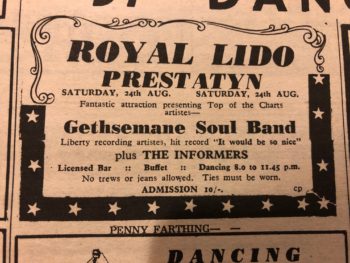
One of the first advertised gigs with the new name (albeit it as Gethsemane Soul Band) was at the Royal Lido Ballroom in Prestatyn, north Wales on Saturday, 24 August.
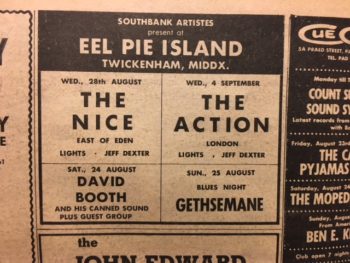
The next day, the group played the first of several shows at Eel Pie Island in Twickenham, west London. The popular island hangout had closed briefly in September 1967 and only reopened on 31 July. Ketley distinctly recalls opening for The Nice at the venue (who were billed to play there on Wednesday, 28 August).
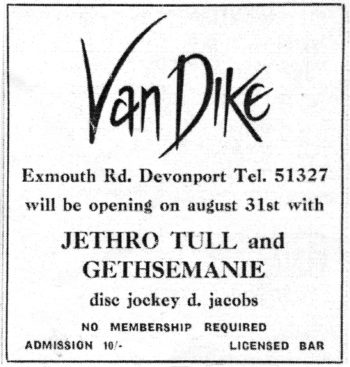
One of the most significant dates during this period was Saturday, 31 August when Gethsemane (misspelt as Gethsemanie) opened the Van Dike Club in Plymouth, Devon, playing first before headliner Jethro Tull. It was the first opportunity that Martin Barre had to check out his future employers.
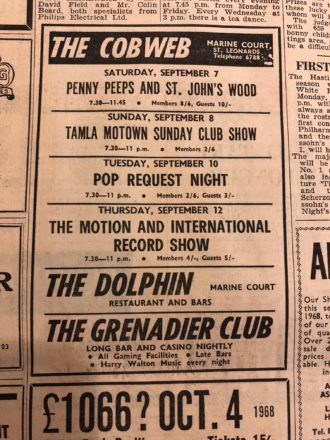
Interestingly, an advertised gig at the Cobweb at St Leonards in East Sussex on Saturday, 7 September (see above) reveals that the group was still occasionally billed as The Penny Peeps, which raises the question of whether Denny Alexander was still a member at this point. (Ed: Ketley says that Alexander had definitely left the band once they had redefined the music they wanted to play and chosen the name Gethsemane.)
Like the previous incarnations, Gethsemane had a busy diary, which increasingly took in blues clubs and the burgeoning university circuit.
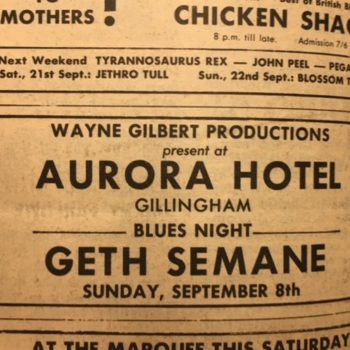
On Sunday, 8 September, the quartet performed at the Aurora Hotel in Gillingham, Kent. That Saturday (14 September), the group (billed as Geth Semane) played one of its most prestigious shows – the Roundhouse in Chalk Farm on a bill that also featured The Scaffold, David Bowie, Junior’s Eyes and The Edgar Broughton Band.

DJ John Peel apparently was a huge fan and recorded the band’s set, which he played the following week on his radio show.
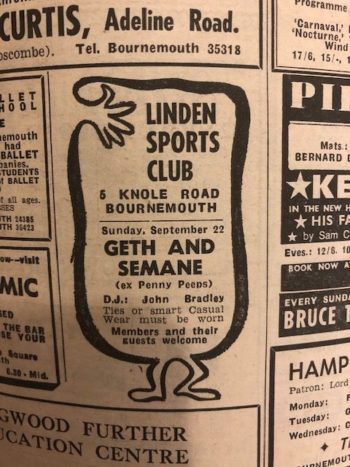
On Saturday, 28 September, Gethsemane played at the Stage Club in Oxford.
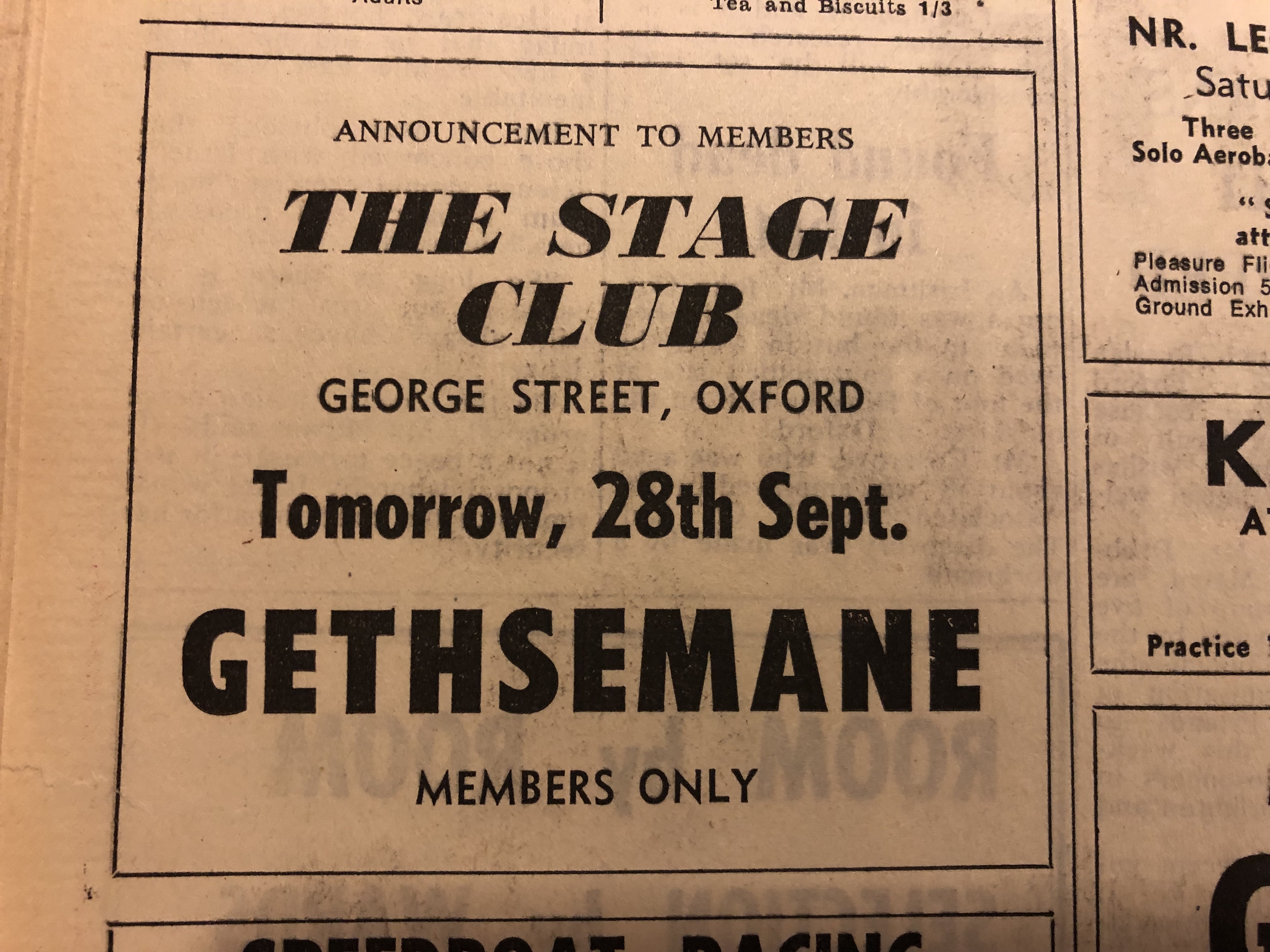
The following Saturday (5 October), the group landed an important gig, opening for blues trailblazers Fleetwood Mac at the Links in Borehamwood, Herts.
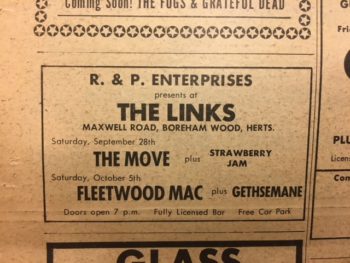
Without Alexander to front the group, the vocals were shared between Malcolm Tomlinson and Mike Ketley.
“Malc always had a great voice,” says Stevens. “We were doing cover versions of The Band as we had got hold of an early copy of Music from Big Pink. If I remember right, Malc sang ‘the Weight’ and ‘Chest Fever’. It was really good.”
Two days after the Fleetwood Mac support gig, the band headed for south Wales to play at the Landland Bay Hotel in Swansea (billed as Gethsemaney).
A few weeks later, on Wednesday, 16 October, the band (billed as Geth Semane) appeared at the Railway Hotel in Bishop’s Stortford, Herts. The group would return to play there on Wednesday, 6 November.
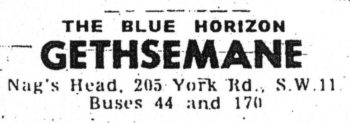
Later that month, Gethsemane appeared at popular blues haunt the Nag’s Head in Battersea on Monday, 21 October and then two days later returned to Eel Pie Island to share the bill with Alan Bown.
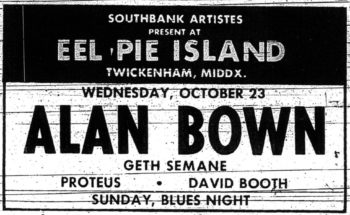
Around this period, Gethsemane piqued the interest of Bee Gees producer Robert Stigwood, and through this association signed with Dick James Music (Northern Songs). While the idea was to record an album, the band soon ran into problems in the studio.
“I have an acetate of Elton John. It’s just him playing at the piano singing ‘Lady Samantha’ which is all about a ghost,” says Ketley.
“Dick James Music, Elton’s publisher gave us a recording to try and do our own version but Elton paid a visit one recording session and said he didn’t like what we were doing with his song so it never went ahead.”
“Musical differences” erupted between the group, Northern Songs and Robert Stigwood. It seems the producer was looking for something much more “poppy” from the group, who also cut a version of “Grease Monkey”, allegedly with future Average White Band member Alan Gorrie providing the bass and lead vocals. At the time, Gorrie’s band Hopscotch were flat mates with Gethsemane.
The decision to cut Elton John’s “Lady Samantha” seemed a rather unusual choice for a blues band. Perhaps the decision was made following an Elton John radio session, taped on 28 October at BBC’s Agolin Hall.
On that occasion, John recorded three tracks – “Lady Samantha”, “Across the Havens” and “Skyline Pigeon”, abetted by a studio group comprising long standing guitarist Caleb Quaye, session bass player Boots Slade (formerly of the Alan Price Set) and Malcolm Tomlinson on drums. The three songs were played on BBC’s Stuart Henry Show the following week.
Whatever the reason, the disappointment and frustration surrounding the LP sessions, together with an aborted attempt to record with guitarist Jeff Beck (the most plausible recording date is 18 September), appears to have been a major factor in driving the band apart.
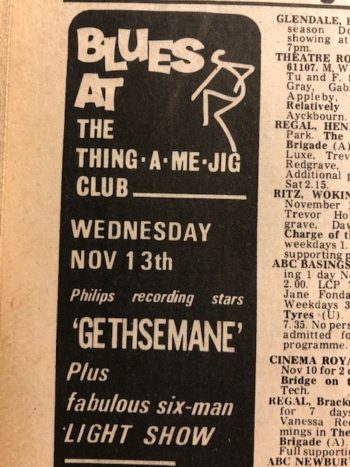
During November 1968, the band ploughed on but was soon running out of steam. After a show at the Industrial Club in Norwich on Friday, 8 November, the group travelled to Reading the following Wednesday to play at the Thing-A-Me-Jig before moving on to Wolverhampton the next evening (14 November) to play the Club Lafayette (billed as Gethsemany).

Back in London, the group landed a gig at the Hornsey Wood Tavern in Finsbury Park the following evening (Friday, 15 November), sharing the bill once again with Jethro Tull. Aware that Mick Abrahams was leaving, Martin Barre auditioned for the guitar spot but it didn’t go well and he worried he’d missed out on his dream job.
With a show at the Crown Hotel in Birmingham on Tuesday, 26 November, Gethsemane began winding down operations, agreeing to split that Christmas.
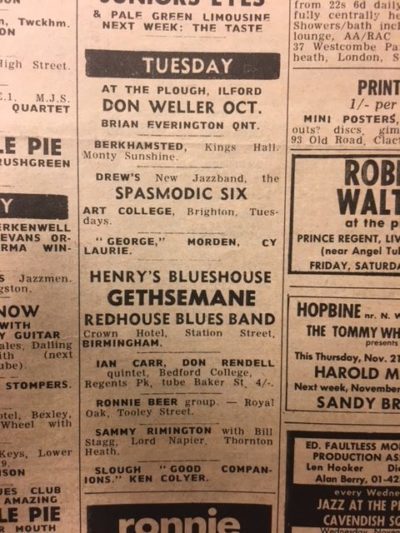
A highly memorable gig at Dundee College of Art on 12 December opening for headliners, Pink Floyd, followed before Gethsemane returned to London to fulfil a few final engagements, including a show at the Pheasantry on the Kings Road, before dissolving.
“The last gig we ever did was at a college in Brook Green, Hammersmith and a guy from Island Records asked if we would be interested in signing up,” says Stevens.
“We didn’t want to know. We had had so many people saying so many times, ‘sign here and we will make you famous!’ Anyway, by that time, we had all decided to go our separate ways.”
Martin Barre has different recollections about Gethsemane’s final gig. “Terry Ellis form Chrysalis approached me to invite me to audition for Tull, which I did a few days later. It was the first one… it took two [to get the position]. He had been sent by Tull to find me and wasn’t interested in the band.”
Having discovered that Mick Abrahams’ replacement Tony Iommi had been dismissed after only a month in the band, Barre phoned Jethro Tull’s singer Ian Anderson to see if he could try out a second time for the band. [Ed – Tomlinson also auditioned at the same time.]
Stevens continues the story: “He didn’t have a very good guitar at the time and mentioned he desperately wanted a Les Paul Gibson for the audition. The guy in the flat below us in our Chiswick flat offered to lend him the £500 – pretty good considering that was quite heavy money in the late ’60s.”
Invited round to Anderson’s flat for a second audition, Barre got the “gig of his dreams”. The rest as they say is history. But what about his former band mates?
Having led a succession of groups from Johnny Devlin & The Detours through to Gethsemane, Bryan Stevens decided to sell his bass and used the money to help finance his studies. Returning to college, he later became a surveyor and currently lives in Chiswick.
Mike Ketley meanwhile returned to the south coast. Switching from keyboards to bass, he joined forces with a several former Noblemen and for a couple of years worked in a local band called The Concords. He later abandoned live work and after leaving music retail, worked for the Hammond Organ Company, then joined Yamaha Music UK retiring as MD after 32 years.
Stevens and Ketley have remained firm friends and in June 2002 re-joined former band mates in a Johnny Devlin & The Detours reunion held in Bognor Regis. Among the guests at the reunion was former Soundtracks guitarist Ray Flacke, who later went on to play with Chet Atkins and Mark Knopfler. Ketley has also re-recorded “Model Village” with his son’s band called The Vybe.
Johnny Devlin and The Detours got together again in 2003 to headline a gathering of ’60s groups from Bognor for a sell-out night in aid of the hospice that looked after Barry Benson (P J Proby’s hairdresser) who had died of cancer a few months earlier. Called “Back to the ‘60s” such was its popularity that the annual event lasted for 10 years and raised nearly £70k for local charities in and around the Bognor Regis area.
Stevens and Ketley were involved in another significant reunion – after over 35 years, they finally met up with Penny Peeps singer Denny Alexander over the Christmas 2004 period. Another reunion took place on 29 March 2009.

They also renewed contact with Malcolm Tomlinson, who, aside from Martin Barre, was the only member of the band to maintain a significant musical profile.
After Gethsemane’s demise, Tomlinson reunited with his former Jeff Curtis & The Flames cohort Louis McKelvey and in February 1969 moved to Toronto, Canada where the pair formed Milkwood with future Celine Dion backing singer Mary Lou Gauthier. (McKelvey, incidentally, had also been one of the hopefuls who auditioned for Ian Anderson and the guitar slot in Jethro Tull).
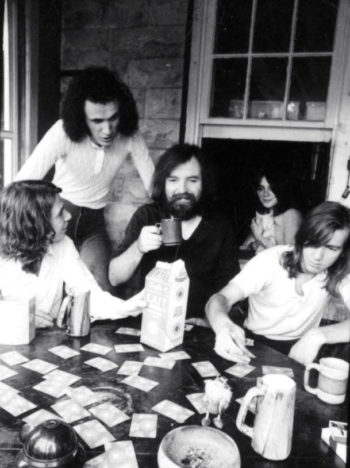
During his first few months in the city, Tomlinson was called on to play drums and flute on ex-A Passing Fancy guitarist and singer/songwriter Jay Telfer’s ambitious solo album, Perch but unfortunately the recording was subsequently shelved, as was Milkwood’s own album, cut in New York that summer for the Polydor label with legendary producer Jerry Ragavoy.
However, Tomlinson did make a notable session appearance on label mate, Life’s eponymous lone album recorded in late 1969, providing a superb flute solo to the Terry Reid cover “Lovin’ Time”.
Milkwood’s greatest claim to fame was appearing at Toronto’s famous Rock ‘N’ Roll Revival concert on 13 September, just before John Lennon’s Plastic Ono Band. Yet despite garnering praise from Jimi Hendrix in Cashbox magazine after he’d spotted the quintet playing at the Penny Farthing club in Yorkville Village, Milkwood imploded shortly after a show in Ottawa in late October.
Next up, Tomlinson briefly played with McKelvey in the short-lived biker group, Damage. One of the band’s most high profile shows was an appearance at the Toronto Rock Festival on 26 March 1970, appearing on the bill with Funkadelic, Luke & the Apostles, Nucleus and Leigh Ashford among others.
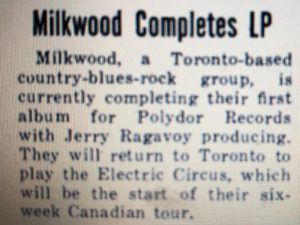
When that group folded in late 1970, Tomlinson briefly teamed up with former Elektra Records band, Rhinoceros before joining Syrinx in October 1971 and recording material for True North Records under the name, JFC Heartbeat.
He then worked with Toronto-based groups, Rambunkshish and Zig Zag alongside Toronto blues guitarist Danny Marks, before signing up with Bill King’s band during 1972.
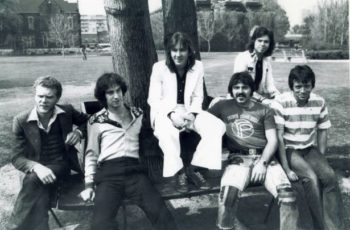
More impressive, in 1973, he recorded an album’s worth of material with Rick James and the original Stone City Band, which is still to see a release.
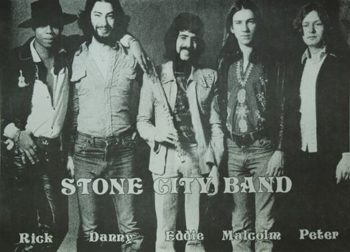
Versatile as ever, Tomlinson subsequently played drums with Jackson Hawke, did sessions for Jay Telfer and then joined Bearfoot before recording two solo albums for A&M Records in 1977 and 1979 entitled Coming Outta Nowhere and Rock ‘N’ Roll Hermit. He dropped out of the recording scene during the ’80s and ’90s.
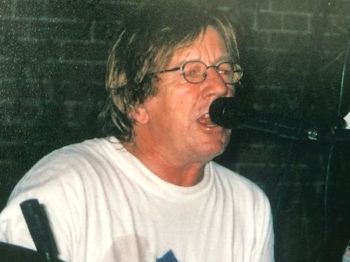
However, in 2007, Tomlinson sang on Toronto group The Cameo Blues Band’s latest album. In June of that year, he played drums with ’60s folk-rock group, Kensington Market to celebrate the “Summer of Love” and also doubled up with Luke & the Apostles. Tomlinson died on 2 April 2016.

Denny Alexander has also passed away. He died on 6 December 2018 and both Mike Ketley and Bryan Stevens were pall bearers at his funeral in January 2019.
Thanks to Bryan Stevens, Mike Ketley, Martin Barre, Denny Alexander and Malcolm Tomlinson.
Copyright © Nick Warburton. All Rights Reserved. No part of this article may be reproduced or transmitted in any form or by any means, without prior permission from the author.
